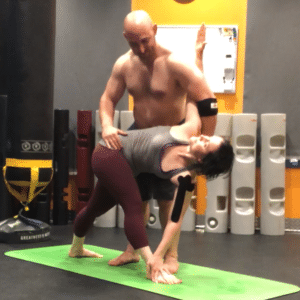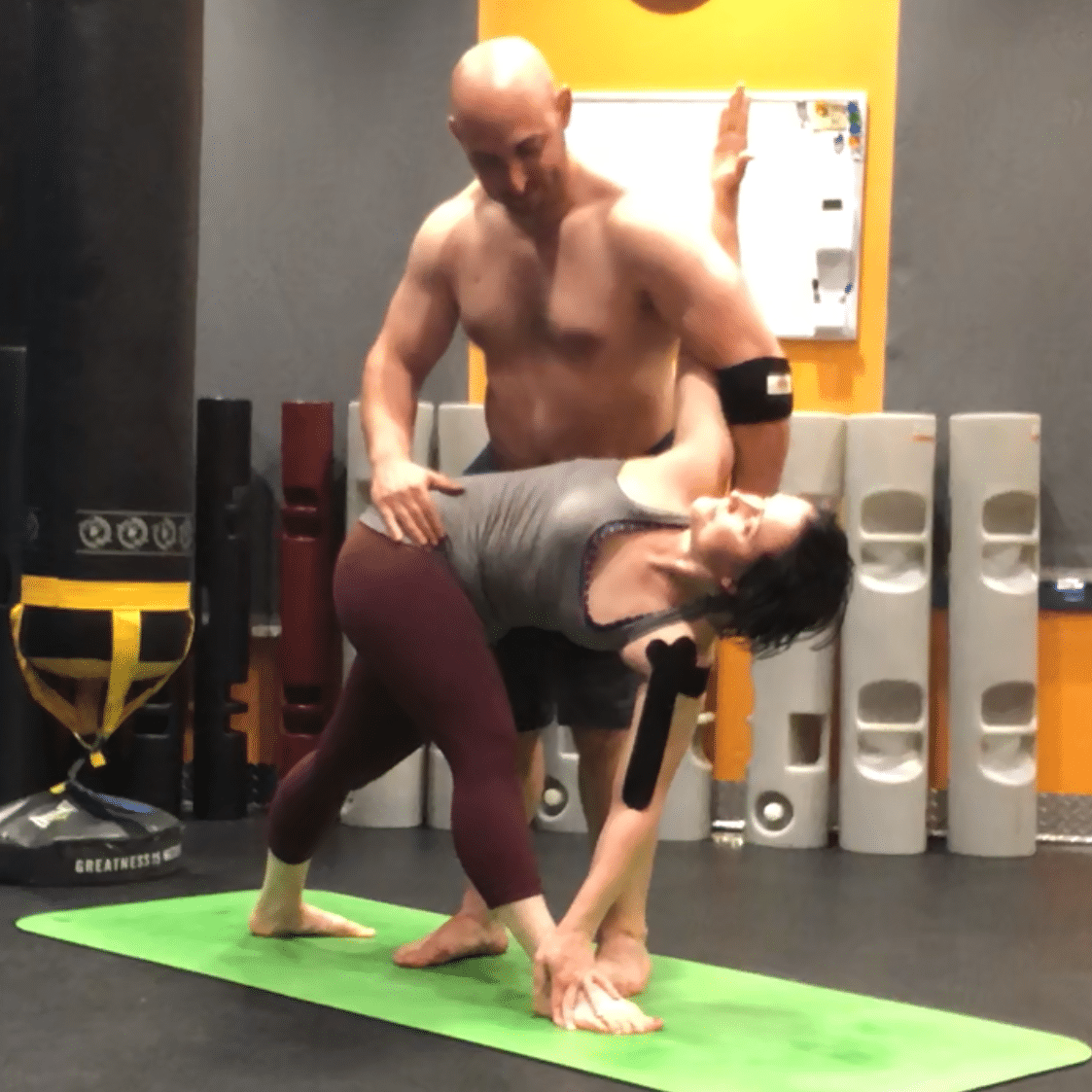Revolved Triangle Pose – Parivrtta Trikonasana: Tips and videos on alignment, partner guiding, & yoga sequencing. Improve thoracic spinal mobility.

Practicing Revolved Triangle Pose (Parivrtta Trikonasa)
The Following instructions assume you are leading with the right foot in Revolved Triangle Pose
- Set the Width: Starting in mountain pose jump both feet to the sides so that they are about a yard apart (wider than a squat stance.)
- Turn to Root the Feet: Turn the right foot 90 degrees to the right (so your toe turns out). Turn the left foot 45-60 degrees to the right. Maintain muscle tightness in the quadriceps to protect the knees. Knees should be open (not bent.) Position the front heel and the back hell in a straight line.
- Set your Base Hand: Rotate your left shoulder so that it comes over your right left leg. Extend you hand down, touch the floor with your palm. You touch to the outside of your right foot. Use a yoga block if you cannot reach the floor.
- Set Your Lead Hand: Stretch the right arm up to the ceiling so that you shoulders are stacked vertically.
- Set your Eyes: Your gaze goes up towards the tips of your fingers and right thumb.
Extended Triangle Pose vs Revolved Triangle Pose (Parivrtta Trikonasa)
Parivrtta Trikonasana is said to be the counter pose Utthita Trikonasana (Triangle Pose).1. In truth, it’s not really a counter pose as compared to downdog vs updog. Extended Triangle pose is a powerful hamstring and oblique stretch. It also improves balance and core strength. Revolved Triangle pose is more of a twisting pose, but one of the few that can be done from a standing position.
Yoga Sequencing with Revolved Triangle Pose (Parivrtta Trikonasa)
Extended Triangle Pose and Revolved Triangle Pose are often sequenced together in flows because transitions between them doesn’t require changing foot positions. Various experts from BKS Iyengar to Mark Stephens 2 often puts Chandrasana, Extended Triangle, Revolved Triangle Pose, Warrior II, Ashta Chandrasa, and Parsvottanasana in the same flows because transitions are simple and fast. Sequencing using these poses creates a deep burn in the legs, because transitions can be accomplished that maintain muscle tension.
Teaching Yoga: Revolved Triangle Pose with a Partner


Straight Spine: One of the most important aspects of the Revolved Triangle Pose (Parivrtta Trikonasa) is the spine should be straight. The teacher or partner should inspect the spine and cue the student to lengthen the spine before allowing the student to rotate. Rotating the spine in a bent position can cause injury.
Stabilize the Yoga Student: Balance in Revolved Triangle Pose (Parivrtta Trikonasa) is challenging. As the teacher, you should position yourself behind the student and help the student maintain balance. Falling in this position (especially for older yogis) can lead to shoulder or back injury. Plus you can also encourage lengthening the spine from this same position.
Rotate from the Shoulder: Never pull on the lead arm. In the picture of me teaching Dawn Parivrtta Trikonasa, I’m bracing her shoulder and biasing her thoracic spine (T-spine) to rotate.
The Hip Handle: In this same picture, you can see that I’m holding onto Illiac Crest (the hip handle) to help Dawn’s Pelvis stay in alignment. New yoga students may try to internationally rotate the hip of the lead leg to gain range of motion. This “cheat” defeats the purpose of the pose, and increases strain on the knee.
